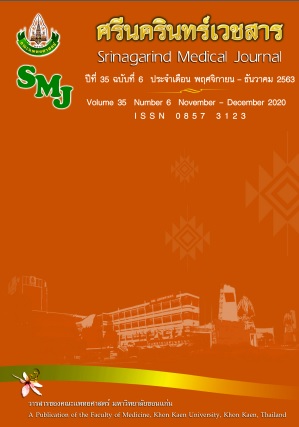ปัจจัยที่มีผลต่อระยะทางที่ได้จากการทดสอบสมรรถภาพทางกายด้วยการเดิน 6 นาที ในผู้ป่วยหลังผ่าตัดหัวใจและหลอดเลือด หลังจำหน่ายออกจากศูนย์หัวใจสิริกิติ์ ภาคตะวันออกเฉียงเหนือ
คำสำคัญ:
การทดสอบด้วยการเดิน 6 นาที; ผ่าตัดหัวใจ; การฟื้นฟูหัวใจบทคัดย่อ
หลักการและวัตถุประสงค์: การทดสอบด้วยการเดิน 6 นาที (6-minute walk test: 6MWT) สามารถทำได้ง่ายและเป็นที่นิยม เพื่อวางแผนการฟื้นฟูหัวใจ ประเมินความสามารถการออกกำลังกาย ติดตามการรักษา และพยากรณ์โรค โดยปัจจัยที่ส่งผลต่อระยะทางการทดสอบการเดิน 6 นาที (6-minute walk distance: 6MWD) มีความหลากหลาย การศึกษานี้จึงมีวัตถุประสงค์เพื่อศึกษาปัจจัยที่มีผลต่อ 6MWD ในผู้ป่วยหลังผ่าตัดหัวใจและหลอดเลือดหลังจำหน่ายออกจากศูนย์หัวใจสิริกิติ์ ภาคตะวันออกเฉียงเหนือ
วิธีการศึกษา:เก็บข้อมูลและตัวแปรที่สนใจจากเวชระเบียนผู้ป่วยหลังผ่าตัดหัวใจและหลอดเลือดที่มาติดตามการรักษาครั้งแรกหลังจำหน่ายออกจากโรงพยาบาล ระหว่างวันที่ 1 พฤษภาคม 2560 ถึง 30 เมษายน 2561 วิเคราะห์ข้อมูลทางสถิติโดยใช้ค่าเฉลี่ย ส่วนเบี่ยงเบนมาตรฐาน ค่าสัมประสิทธิ์สหสัมพันธ์ และการวิเคราะห์ถดถอยพหุคูณแบบขั้นตอน
ผลการศึกษา: กลุ่มตัวอย่าง 153 ราย มีค่า 6MWD 276.05 ± 74.43 เมตร ปัจจัยที่มีความสัมพันธ์กับ 6MWD ได้แก่ อายุ เพศ ส่วนสูง อัตราการเต้นหัวใจสูงสุดระหว่างทดสอบ และระดับความรู้สึกเหนื่อยก่อนทดสอบ โดยปัจจัยที่ร่วมกันพยากรณ์ 6MWD (r2 = 0.288, p < 0.001) ได้แก่ อายุ เพศ และระดับความรู้สึกเหนื่อยก่อนทดสอบ
สรุป: ปัจจัยที่ร่วมกันพยากรณ์ 6MWD ในผู้ป่วยหลังผ่าตัดหัวใจและหลอดเลือดหลังจำหน่ายออกจากศูนย์หัวใจสิริกิติ์ ภาคตะวันออกเฉียงเหนือ ได้แก่ อายุ เพศ และระดับความรู้สึกเหนื่อยก่อนทดสอบ
References
2. Srivanichakorn S. Morbidity and mortality situation of non-communicable diseases (diabetes type 2 and cardiovascular diseases) in Thailand during 2010-2014. Disease Control Journal 2017; 43: 379-390.
3. Kulik A, Ruel M, Jneid H, Ferguson TB, Hiratzka LF, Ikonomidis JS, et al. Secondary prevention after coronary artery bypass graft surgery: a scientific statement from the American Heart Association. Circulation 2015; 131: 927-964.
4. Goel K, Lennon RJ, Tilbury RT, Squires RW, Thomas RJ. Impact of cardiac rehabilitation on mortality and cardiovascular events after percutaneous coronary intervention in the community. Circulation 2011; 123: 2344-2352.
5. Suaya JA, Stason WB, Ades PA, Normand SL, Shepard DS. Cardiac rehabilitation and survival in older coronary patients. J Am Coll Cardiol 2009; 54: 25-33.
6. Santos PM, Ricci NA, Suster ÉA, Paisani DM, Chiavegato LD. Effects of early mobilisation in patients after cardiac surgery: a systematic review. Physiotherapy 2017; 103: 1–12.
7. Shepherd CW, While AE. Cardiac rehabilitation and quality of life: A systematic review. Int J Nurs Stud 2011; 49: 755-771.
8. Ueshima K, Kamata J, Kobayashi N, Saito M, Sato S, Kawazoe K, et al. Effects of exercise training after open heart surgery on quality of life and exercise tolerance in patients with mitral regurgitation or aortic regurgitation. Jpn Heart J 2004; 45: 789-797.
9. American Thoracic Society. ATS statement: Guidelines for the six-minute walk test. Am J Respir Crit Care Med 2002; 166: 111-117.
10. Opasich C, De Feo S, Pinna GD, Furgi G, Pedretti R, Scrutinio D, et al. Distance walked in the 6-minute test soon after cardiac surgery: toward an efficient use in the individual patient. Chest 2004; 126: 1796-1801.
11. Fiorina C, Vizzardi E, Lorusso R, Maggio M, De Cicco G, Nodari S, et al. The 6-min walking test early after cardiac surgery. Reference values and the effects of rehabilitation programme. Eur J Cardiothorac Surg 2007; 32: 724-729.
12. Ingle L, Cleland JG, Clark AL. The relation between repeated 6-minute walk test performance and outcome in patients with chronic heart failure. Ann Phys Rehabil Med 2014; 57: 244-253.
13. Hasin T, Topilsky Y, Kremers WK, Boilson BA, Schirger JA, Edwards BS, et al. Usefulness of the six-minute walk test after continuous axial flow left ventricular device implantation to predict survival. Am J Cardiol 2012; 110: 1322–1328.
14. Cacciatore F, Abete P, Mazzella F, Furgi G, Nicolino A, Longobardi G, et al. Six-minute walking test but not ejection fraction predicts mortality in elderly patients undergoing cardiac rehabilitation following coronary artery bypass grafting. Eur J Cardiovasc Prev Rehabil 2012; 19: 1401–1409.
15. La Rovere MT, Pinna GD, Maestri R, Olmetti F, Paganini V, Riccardi G, et al. The 6-minute walking test and all-cause mortality in patients undergoing a post-cardiac surgery rehabilitation program. Eur J Prev Cardiol 2015; 22: 20-26.
16. Bellet RN, Adams L, Morris NR. The 6-minute walk test in outpatient cardiac rehabilitation: validity, reliability and responsiveness-a systematic review. Physiotherapy 2012; 98: 277–286.
17. Oliveira GU, Carvalho VO, de Assis Cacau LP, de Araújo Filho AA, de Cerqueira Neto ML, da Silva WM, et al. Determinants of distance walked during the six-minute walk test in patients undergoing cardiac surgery at hospital discharge. J Cardiothorac Surg 2014; 9: 1-6.
18. Kittipanya-ngam P, Yasud M. Six-minute walk test in Thai cardiac-surgery elderly at Queen Sirikit Heart Center of the Northeast. Srinagarind Medical Journal 2020; 35: 161-166.
19. Cohen J. Statistical power analysis for the behavioral sciences. 2nd Ed. Hillsdale: Lawrence Erlebaum; 1988.
20. Elifson KW, Runyon RP, Haber A. Fundamentals of social statistics. New York: McGraw-Hill; 1990.
21. Cacau LD, Santana-Filho VJ, Maynard LG, Gomes Neto M, Fernandes M, Carvalho VO. Reference values for the six-minute walk test in healthy children and adolescents: a systematic review. Braz J Cardiov Surg 2016; 31: 381-388.
22. Enright PL, Sherrill DL. Reference equations for the six-minute walk in healthy adults. Am J Respir Crit Care Med 1998; 158: 1384-1387.
23. Casanova C, Celli BR, Barria P, Casas A, Cote C, De Torres JP, et al. The 6-min walk distance in healthy subjects: reference standards from seven countries. Eur Respir J 2011; 37: 150–156.
24. Eston R. Use of ratings of perceived exertion in sports. Int J Sports Physiol Perform 2012; 7: 175-182.
25. Eston RG, Thompson M. Use of ratings of perceived exertion for prediction of maximal exercise levels and exercise prescription in patients receiving atenolol. Br J Sports Med 1997; 31: 114–119.



